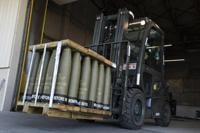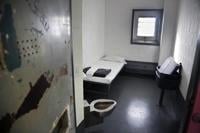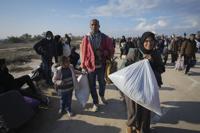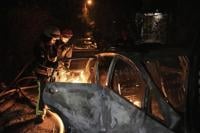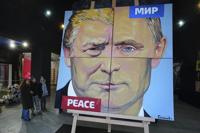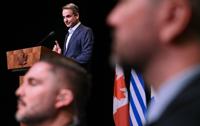WASHINGTON (AP) — The U.S. will send Ukraine about $500 million in ammunition and equipment and spend more than $2 billion to buy an array of munitions, radar and new weapons to help Kyiv counter drones in the coming months, the Pentagon said Tuesday, as Ukrainian troops gear up for a spring offensive against Russian forces.
The aid to be taken from military stockpiles so it can be in quickly includes "ammunition for U.S.-provided HIMARS, air defense interceptors, and artillery rounds that Ukraine is using to defend itself,” Secretary of State Antony Blinken said in a statement. HIMARS are multiple rocket launchers.
The package includes at least two new weapons systems that are designed to counter drones — specifically the Iranian-made Shahed, which Tehran has provided to Russia and has been heavily used in attacks on Ukrainian cities.
The U.S., for the first time, will send nine 30mm gun trucks and an undisclosed amount of ammunition for them, and 10 mobile laser-guided rocket systems, also developed to counter drones.
The wide array of ammunition being sent from Pentagon stocks includes 155 mm artillery rounds for howitzers as Ukraine burns through the rounds fighting back against Russia's ground invasion. The Pentagon does not provide the amounts of munitions in most cases.
The immediate assistance also includes anti-armor systems, small arms, heavy equipment transport vehicles, 61 fuel tankers and maintenance support, the Pentagon said in a statement.
A senior defense official said the focus is on helping Ukraine change the dynamic on the ground. Right now, the official said, the battle lines are relatively static and neither side has gained much territory. The official, who briefed Pentagon reporters on condition of anonymity to provide military details, said the U.S. wants to help Ukraine advance and hold its positions in the expected counteroffensive.
“We very much appreciate everything that the United States has done specifically in the last month to help our army prepare itself for the counteroffensive,” said Ukrainian Foreign Minister Dmytro Kuleba, speaking at NATO headquarters in Brussels before a meeting with with Blinken. “The Biden administration has upheld its commitment to provide Ukraine with a lot of what we need and set an example to other allies.”
The $2.1 billion in longer-term aid, which is being provided under the Ukraine Security Assistance Initiative, will buy missiles for the ���ϳԹ��� Advanced Surface-to-Air Missile System, or NASAMS, as well as radar, additional satellite terminals and fuel tanker trucks, anti-armor rockets and bridging systems. It also will fund additional training for Ukraine's forces.
The defense official said weapons already bought using the security assistance funding in previous packages are beginning to make their way to the battlefield. That is key because in some cases — such as with the 155 mm rounds — the Pentagon had been sending its own stocks, which are also needed for American troop training, and there is a finite supply. Now, the official said, the deliveries of 155 rounds Ukraine is getting include ammunition that was bought a number of months ago through the USAI program.
The new weapons and money come as Russia has continued to bombard Ukraine with and the hotly contested battle for drags on. Ukrainian President Volodymyr Zelenskyy told The Associated Press in that unless his country wins that fight, Russia could begin building international support for a deal that could require Ukraine to make unacceptable compromises.
Zelenskyy said if Moscow's forces take Bakhmut, Russian President Vladimir Putin would “sell this victory to the West, to his society, to China, to Iran.”
The latest U.S. package, with its mix of short-term and long-term aid, involves a wide variety of ammunition from Pentagon stocks, 23 million rounds of small arms ammunition and 200,000 grenades, mortars, rockets and an array of precision guided munitions.
It brings the total amount of U.S. security assistance to Ukraine to more than $35.1 billion since . Defense leaders testifying on Capitol Hill last week said the U.S. is prepared to support Ukraine for as long as needed.
NATO Secretary-General Jens Stoltenberg has echoed that sentiment, saying the alliance’s foreign ministers meeting in Brussels were discussing how to step up support for Ukraine’s armed forces. “Our support is for the long haul," he said before the meeting Tuesday.
The White House said last week that it has new evidence that for weapons as it also prepares for a spring offensive. Russia would provide Pyongyang with needed food and other commodities in return.
U.S. officials also are concerned that the president of Belarus has warned that Russian strategic nuclear weapons might be deployed in his country, along with part of Moscow’s tactical nuclear arsenal.
Putin has said he planned to place tactical nuclear weapons in neighboring Belarus. Those weapons are comparatively short-range and low-yield. Strategic nuclear weapons, such as missile-borne warheads, would be a greater threat.
Belarusian President Alexander Lukashenko, while talking up the possibility of nuclear weapons, has also called for a cease-fire in Ukraine. He said a truce must have no preconditions and all movement of troops and weapons must be halted.
Russia, however, has rejected a cease in fighting, claiming that Ukraine has refused to enter talks under pressure from its Western allies.
_____
Lee reported from Brussels. Associated Press writer Tara Copp contributed to this story from Washington.


